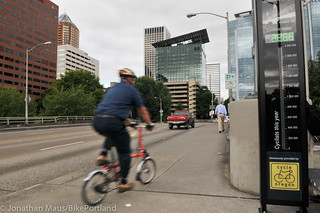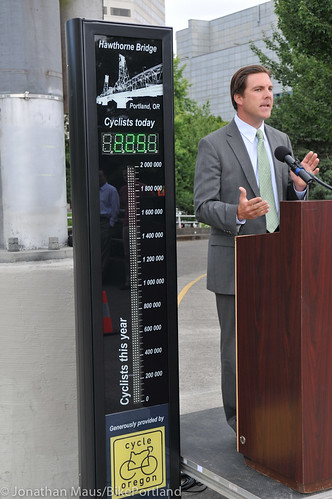From now on, people crossing the Hawthorne Bridge by bike will count. Literally. A new bike counter (a.k.a. the bicycle barometer) — the first of its kind in the United States — went live at midnight last night and at this morning’s press conference the number was already well over 2,000.
The event was a chance for the City of Portland to unveil the new counter; but the moment really belonged to Cycle Oregon, the local non-profit that gave the City $20,000 to make it a reality. (The idea for the counter came from PBOT Bike Coordinator Roger Geller. Read more background in our archives.)
Jonathan Nicholas, the former columnist for The Oregonian who co-founded Cycle Oregon, was on hand this morning. As usual, his words cut through the clutter and I think they’re worth sharing verbatim:
“The first thing I want to make clear today is that this bike counter is not part of a spandex revolution. The last thing our city needs is more middle-aged men in tight pants. What our city needs is more young men and women with decent paychecks. This bike counter is really part of job creation in our city.
It’s no secret that health care costs are threatening to cripple our urban economy and they’re really inhibiting job creation. We have to find a way for urban dwellers to live more active lifestyles and therefore be healthier. One key part of that is making it easier and safer for people to walk and cycle around our city and one key to making those sort of investments is having accurate, real-time data on which you can base those investments. This counter is all about that.
We’re delighted of course that it’s the first… But this is much more than a game; much more than about beating Seattle — although it’s always nice to beat Seattle to anything. This is a gift. It’s our 25th anniversary and so much of our work that we’ve done through the years has been about rural Oregon. All the money generated through the Cycle Oregon Fun goes back to community developments grants in rural Oregon. But we understand very much that the success we’ve achieved through these year is because so many of the men and women from the city have come out and ridden around Oregon with us.
So here on our 25th anniversary we wanted to sort of give a birthday present back to the citizens of Portland to thank them for all of that support. And so this bike counter is from Cycle Oregon to the City of Portland and we look forward to partnering on many more such ventures in the future.”
The counter has been placed on the northern side of the west end of the Hawthorne Bridge, right where the path splits off onto Waterfront Park and into downtown. Standing at about eight feet high, it features an illuminated tally of “Cyclists today” and a vertical chart of “Cyclists this year” (that goes up to 2,000,000).
The counter works via four sets of air hoses strung across the Hawthorne Bridge path (see images below). There are two sets of two hoses placed about 10-15 feet apart on both sides of the bridge. According to PBOT data collection expert Tom Jensen, when someone on a bicycle rolls over the hoses, their weight depresses the hose, which creates a pulse that is converted into a radio signal that beams wirelessly to the counter.
PBOT bike coordinator Roger Geller said they’re using air hoses instead of induction loops (commonly used to trigger traffic signals) because the hoses are more accurate.
Jensen said that while no system is perfect, they’ve rigged the hoses and counter specifically to only register bicycle trips (not walkers, skateboarders, and so on). The system has been set up to only register a trip if it senses a pulse at a certain timing sequence (which is why there are two sets of hoses to run over). The pulse must also have a certain strength. If the pulse isn’t strong enough and if the timing is off, the counter won’t register the trip. Also, if there is something blocking the counter, the radio frequency signal could be blocked (which happened briefly this morning as people stood in front of it).
PBOT’s annual bike counts have been using similar hoses for many years, so they don’t expect the number shown on the new counter to be much different. If that holds true, we can expect well over 8,000 trips registered per day (and we’ll burst the counter’s 2 million trip high water mark in just eight months).
There has been some confusion (party my fault) as to whether or not this is the first bike counter in all of North America. There was some chatter at the event today that — while other counters exist in Ottawa, Montreal, and Toronto, Canada — this was the first one to have a public display (even PBOT’s official press release states: “Portland’s bike counter is the first of its kind in North America”). However, Ottawa resident Alex deVries shared with me via Twitter that not only do they have a counter, the numbers are beamed to a web site and there’s also an illuminated display on the street.
PBOT says they’re considering uploading the data to a website, but it’s not available yet. (UPDATE: Eco-Counter, the company we bought the counter from, has published a website with the data.)
But, as Jonathan Nicholas said, this isn’t about who’s first. It’s also not just about the data (PBOT already has access to high-quality bridge bike count data). In many ways, this is about Portland promoting bicycling in a very public way. The running tally is a validation that bicycle trips make up a major portion of Hawthorne Bridge traffic (currently about 20 percent of the total). And while many of us already knew that; now many others will too. This type of positive reinforcement for a behavior the city wants to encourage is a key part of what makes cycling in cities like Amsterdam and Copenhagen (where we got the idea in the first place) such a big deal.
Yes, I’d rather have a big press conference to unveil a new separated bikeway that connects the Hawthorne Bridge to the South Park Blocks; but this definitely a cool thing and I’m proud and grateful that Roger Geller, PBOT, and Cycle Oregon made it happen for us.






